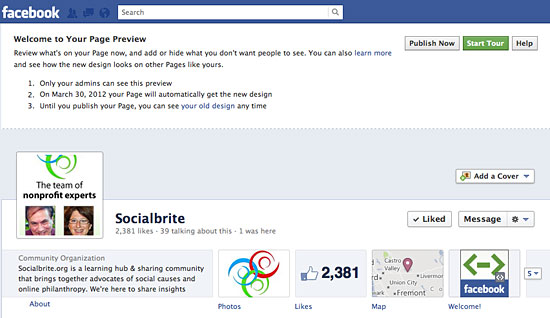
Socialbrite has not yet switched over to the new Timeline — but we will by Friday!
It’s time to leap into action — the switchover happens Friday
Target audience: Nonprofits, foundations, NGOs, social enterprises, cause organizations, brands, businesses, Web publishers, educators, journalists, general public.
Editor’s note: Facebook is switching over all nonprofit and business pages to the new Timeline format this Friday, March 30. Because so many organizations haven’t yet made the move, or are still figuring out the best approach, we’re devoting this week to help you get ready to make the transition smartly. Contact Socialbrite if you need help.
In this series:
• Tuesday: How to shape your nonprofit’s message in Timeline
• Wednesday: Tips on maximizing the new Timeline
• Thursday: What story should you tell in Facebook Timeline?
Also:
• Make Facebook Timeline about your community
• How to create Facebook Timeline covers for your nonprofit’s supporters to use
• 11 ways Facebook Timeline changes your content strategy
Guest post by Beth Kanter
bethkanter.org
If you are an administrator for your organization’s Facebook page, you’ve no doubt noticed the alert that invites you to preview the look of your new page with the option of publishing it for all the world to see. Between now and March 30, only page administrators can see the changes, if you haven’t set it live yet. On Friday, Facebook will flip the switch for everyone. Many large nonprofits and big brands already have.

Livestrong is one of the nonprofit early adopters that has published its brand page using the new format. Others are exploring and testing and fixing glitches or simply checking out the new features, like the administrator’s dashboard. Time is runnnig out, so you have a few days left to review the changes, figure out a strategy and implement the changes.
Recommendations on optimizing your new Timeline
Here are my suggestions:
1Strategy and work flow. Understand how the changes impact your editorial strategy and how you will administrator the page. I shared a couple of resources and tips that you can use to have a brief strategy discussion with your team. After you have identified how you will integrate your branding strategy, revise your editorial/content strategy, and administrative work flow, you’re ready to get into some nitty gritty.
2Take the tour. Block out an hour to sit down and take the tour and preview your page. I would print out a copy of this useful guide published by Facebook that summarizes the feature changes. Go through the tour and take notes. See if your old profile image works with the new format. You might also want to check out how some brands have already implemented the changes. Mashable has this post on preparing for your new page.
3Bye bye default landing tabs. You’ll also notice that the landing tabs have now disappeared. This is a change that some nonprofits do not like. But there is a new feature called “pinned posts,” which are posts that remain at the top of your Timeline. Think of these pinned posts as your old landing tab. A pinned post stays at the top for only seven days. So this is where you’ll have to figure what your weekly call to action is. Looks like the emphasis is squarely on engagement vs. getting new likes.
4Profile and cover images. Many nonprofits may not have the graphic designer resources and will needed to take a DIY approach, while others will need to provide their designers with nitty gritty information like image size for the cover image. Here’s a quick cheat sheet. Also keep in mind that there are some important rules around the cover image about what information you can or can’t include.

5Administrative dashboard. Facebook has given us a nice administrative dashboard that lets us see our metrics and fan activity in an easy-to-scan screen. If you aren’t measuring how your content is engaging and resonating with your fans as part of your content strategy decision-making, hop to it. Here are some tips and ideas to get you started. Remember, to get the best results you need both real-time and trend data.
6Private messaging to administrators. Your page administrators will be able to communicate privately with fans using the page identity. This will make it easier for a team approach to managing your fan page community. It will be good think through how you will handle and manage private communications with fans.
7Prepare for your launch. Plan out how you want to launch your brand to your fans. What are you going to say about it? How are you going to get the word out on your page and other channels. I put together a small pinboard of the resources in this post to help you plan for the change this week.
What’s your plan for switching to the new format? Share in the comments below.
Related
• Facebook Welcome Pages are dead — say hello to Timeline (Socialbrite)
• What Facebook Timeline apps are really all about (Socialbrite)
• Why Timeline is a colossal blunder for Facebook (J.D. Lasica)
 This work is licensed under a Creative Commons Attribution 3.0 Unported.
This work is licensed under a Creative Commons Attribution 3.0 Unported.








